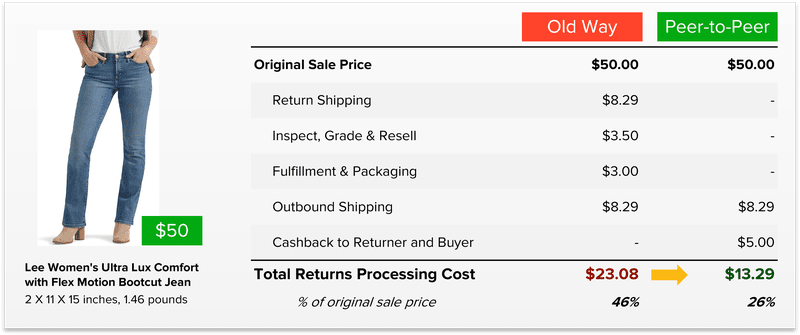Managing Cross-Border Ecommerce Returns: Strategies & Solutions

Last updated on April 25, 2025

As ecommerce continues to grow in the global marketplace, the challenge of managing cross-border returns has become one of the most complex yet crucial aspects for online stores selling internationally. Cross-border ecommerce returns involve unique complexities, from dealing with international shipping and customs regulations to managing customer expectations and reducing logistics costs. With consumers increasingly shopping across borders, understanding how to streamline returns processes while maintaining customer satisfaction is vital for ensuring a competitive edge.
This article explores the challenges of managing cross-border returns, the best strategies to handle them effectively, and the tools and systems that can improve the cross-border returns management process. By implementing the right strategies, businesses can reduce operational costs, improve profit margins, and increase customer loyalty.
Understanding the Challenges of Cross-Border Ecommerce Returns
Cross-border returns come with a range of challenges that are not as prominent in domestic returns. Some of the primary issues include:
1. Shipping Costs and Logistics Complexity
International shipping is often one of the most significant costs when handling cross-border returns. Shipping challenges, such as last-mile delivery, duties, and taxes, can quickly add up. For international customers, businesses often offer free returns, but the costs associated with international returns can become substantial, especially if the company offers return shipping at no charge.
Moreover, the logistics process for cross-border returns requires careful coordination between warehouses, fulfillment centers, and logistics providers. Managing returns across borders increases complexity, particularly when dealing with return labels and ensuring proper customs clearance.
2. Duty and Tax Management
When it comes to international returns, businesses need to consider duty and tax management. Different countries have varying customs duties, taxes, and procedures for processing returns. Handling returns from global markets can involve navigating differing regulations and managing customs procedures to ensure that returned products pass through customs smoothly without incurring additional charges.
For businesses, this means understanding how customs clearance works for returns, the impact on profit margins, and the potential for added shipping costs when items are sent back internationally.
3. Customer Expectations
Managing returns from international customers comes with the challenge of meeting diverse expectations. Customers expect hassle-free returns regardless of location, and if an ecommerce store cannot provide a smooth return process, it can severely damage brand reputation. Offering store credit or flexible return policies can help manage expectations and retain customer loyalty, even when returns are difficult to process.
Customer loyalty hinges on the returns experience. Shoppers who encounter difficulties are likely to abandon your brand in favor of one that offers a more customer-friendly solution. Having a well-structured, efficient returns policy that meets international standards helps foster long-term relationships and increase customer lifetime value.
4. Language Barriers and Communication Issues
Another hurdle in managing cross-border returns is dealing with language barriers. If a business operates in multiple regions, offering multilingual support for return policies and return labels is essential. Customers in non-native languages might struggle to understand return instructions, leading to errors and frustration. Providing support in native languages or clear return labels with easy-to-understand instructions can go a long way in mitigating these issues.
Strategies for Managing Cross-Border Ecommerce Returns
Now that we understand the challenges, let’s look at the strategies and solutions that can streamline the cross-border returns process and improve both customer experience and profit margins.
1. Create a Clear and Flexible Returns Policy
One of the most important elements of cross-border returns management is having a clear and flexible returns policy. Make sure customers know exactly how and when they can return items, what costs are involved, and what options are available (e.g., store credit instead of a refund, exchange, or partial refund).
A customer-friendly solution, like offering free returns or a generous return period, helps increase satisfaction. However, offering too many return options without managing them properly could lead to higher-than-expected return rates, so it’s essential to set clear guidelines.
Pro Tip: Ensure your returns policy is well-communicated on your marketplaces and online stores. Inform customers upfront to reduce misunderstandings later.
2. Leverage Technology and Returns Management Systems
Implementing a comprehensive returns management system is one of the most effective ways to manage returns. These systems provide visibility into the returns process and automate tasks like issuing return labels, processing shipping returns, and tracking merchandise.
By leveraging returns management software, you can streamline cross-border returns, reduce manual work, ensure inventory visibility, and make the process more efficient. This automation also helps manage return data—identifying reasons for returns and adjusting business decisions accordingly.
Pro Tip: Invest in a returns management system that integrates seamlessly with your ecommerce platforms and logistics providers to reduce delays and errors.
3. Partner with Logistics Providers for Cross-Border Shipping
Since cross-border shipping often represents the largest cost of international returns, partnering with reliable logistics providers who specialize in cross-border ecommerce can help lower expenses. Working with global logistics companies that offer efficient, cost-effective solutions—such as consolidation services—can protect your profit margins.
Consider offering return hubs in key regions or using local drop-off points to avoid cross-border shipping altogether.
Pro Tip: Consolidate international returns to regional hubs or return centers to reduce shipping time and logistics costs.
4. Simplify Customs and Duties Management
Navigating customs regulations and tax management is one of the most complicated aspects of international returns. To streamline the process, consider offering duty-paid returns or partnering with logistics providers experienced in customs clearance.
Automated duty and tax management systems can calculate any charges due on returned goods, ensuring no unexpected costs for customers or your business.
Pro Tip: Partner with a logistics provider specializing in international returns and customs management to ensure smooth clearance.
5. Provide Multilingual Support
As your business grows into new international markets, offering multilingual support becomes essential. Provide customer support in various languages and make sure return policies and return labels are available in customers’ native languages.
This simple step ensures that online shoppers understand the returns process, minimizing confusion and reducing the likelihood of returns due to customer misunderstanding.
Summary: Maximizing Profitability with Cross-Border Returns
Managing cross-border returns can be complex, but with the right strategies, ecommerce businesses can transform challenges into opportunities for increased loyalty, improved efficiency, and higher margins. By streamlining returns, offering clear policies, leveraging technology, and partnering with expert logistics providers, you’ll enhance customer satisfaction, lower costs, and gain a competitive edge globally.
Success requires careful planning, continuous improvement, and a customer-centric approach—key to building a smooth, seamless returns experience that drives sustainable growth.
Frequently Asked Questions
What are the main challenges of cross-border returns?
The main challenges include high shipping costs, customs procedures, inventory visibility, and meeting customer expectations. These can be mitigated with returns management systems, global logistics partners, and clear return policies.
How can I reduce cross-border returns?
Focus on accurate product descriptions, product quality, comprehensive size guides, personalized recommendations, and a clear returns policy. Data analytics can also help identify trends and reduce returns caused by dissatisfaction.
Why is multilingual support important for cross-border returns?
Multilingual support ensures customers understand your policies, labels, and support in their language, minimizing confusion and improving the returns experience.
How can I optimize logistics for cross-border returns?
Partner with logistics providers specializing in cross-border shipping and reverse logistics. Use regional hubs or local drop-off points to streamline the return process and reduce costs.
How do I handle customs and duties for international returns?
Managing customs and duties for international returns can be complex, but by partnering with logistics providers experienced in customs clearance and using duty-paid returns systems, businesses can simplify the process and ensure there are no unexpected costs for customers or the business.

Up to 64% Lower Returns Processing Cost


 7 minutes
7 minutes